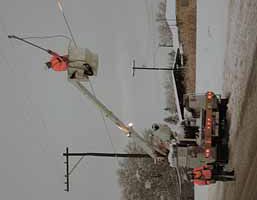| Utah Power & Light crews work to restore service to outage areas in Carbonville last Friday. Power disruptions were widespread throughout Utah. |
During the Christmas weekend, there were numerous disruptions in electrical service reported throughout the state.
In Carbon County, the outages did everything from flicker and knock out settings on clock radios to take down furnaces for up to four hours.
The worst disruption occurred in Salt Lake, where 70,000 customers were without power at one point. On Monday, more than 2,000 consumers were still without service.
Power disruptions are common when heavy weather hits. Moisture and tree limbs falling on overhead lines create the biggest problem for power companies. Last weekend, Utah Power and Light had more than 500 ewmployees working in the field to repair lines.
Linemen along the Wasatch Front said people’s reactions to the outage varied. Some consumers appreciated the fact that the crews were out in the cold on a holiday working on the lines. Others people reportedly threw snowballs and rocks at workers, while some others threatened power company personnel.
“We are working as swiftly as we can to restore power to everyone,” pointed out UP&L spokesman Dave Eskelson over the weekend. “But our primary concern is that the crews work safely. That means they work carefully so they can’t always move as quickly as some people would like them to.”
Customers also may do things during power outages that create safety problems, especially in the winter.
Utah Power and Light offers the following tips to assist local residents in dealing with winter outages:
•Do not use stoves, heaters or combustion appliances inside that are designed for use outside.
•Do not use natural gas stoves and ovens for space heating purposes.
Exercise caution when using wood-burning stoves and fireplaces.
They have also issued some other more general safety practices that customers should follow both inside and outside their homes.
•Stay away from downed lines and trees in the power lines.
•Do not try to extract tree branches that are touching or have fallen from power lines.
•Exercise caution when using candles or open flames for light or heat inside homes and apartments.
Keep flashlights, a battery-operated radio, batteries, water, non-perishable food items, extra blankets or clothes and a mobile/cellular phone handy.
•Turn on front porch lights so field personnel can tell when power comes back on in an area. Turn off lights and appliances to reduce initial system demand when power is restored.
•For extended outages, keep refrigerator and freezer doors closed as much as possible. Consider moving perishable food outside or into an unheated garage.
•Check on elderly or infirm neighbors and relatives who might be in need in an outage.
•Use generators with caution. Generators can pose serious safety hazards when improperly used or installed. Always follow the manufacturer’s instructions.
•Never plug a generator into an outlet. Don’t connect a generator directly to a home’s main fuse box or circuit panel.
•If temporary power must be provided, a generator should be connected through an approved transfer switch that will isolate the house from the power company’s system. The switch must comply with the National Electric Code and local building codes. Compliance includes securing permits, inspections and having such a device installed by a licensed electrician.
•To temporarily power an appliance, plug it directly into the generator.
•Use properly sized and grounded extension cords, and keep cords hidden so they don’t present a tripping hazard.
•Always properly ventilate a portable generator. Gasoline-powered generators produce carbon monoxide and the fumes can be deadly. Make sure that the total electric load on a generator won’t exceed the rating.

